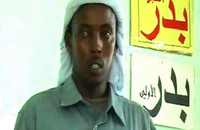|
|
|
Aden Hashi Ayro, the deceased leader of al Qaeda-linked Shabaab, the terrorist youth movement of Somalia’s Islamic Courts Union. Photo from IntelCenter |
Over the past several years, an ongoing lack of internal order has left Somalia vulnerable to the rise of hard-line Islamist groups, of which the latest is al Shabaab (“the youth”), which has risen from obscurity to international prominence in less than two years. Al Shabaab’s ideological commitment to global jihadism, its connections to al Qaeda, its military capabilities, and its ability to capture and control territory suggest that it will continue to pose a strategic challenge to both the US and Somalia’s neighbors.
Today Middle East Quarterly posted a lengthy article that I wrote on al Shabaab, which appears in the Fall 2009 issue. It provides fairly extensive background on the organization, its capabilities and outlook, and how it fits into the broader fight against Islamist terrorism.
Today, al Shabaab is a capable fighting force that implements a strict version of Shari’a in key areas of Somalia. Its range is enhanced by training camps from which many Western Muslims have graduated. This has made al Shabaab a significant security concern to several countries, including the United States.
Terrorist training. Given the relationship … between Al-Shabaab and Al-Qaeda, which includes ideological affinity and interlocking leadership, there are worries about Al-Shabaab’s connections to transnational terrorism. These concerns are bolstered by Al-Shabaab’s operation of terrorist training camps, successors to the [Islamic Courts Union] camps.
One of the clearest signs that training camps have reopened in Somalia is an exodus of young Somali men from Minneapolis-St. Paul and elsewhere in the United States. There are further reports of young Somali men going missing from Canada, Europe, Australia, and Saudi Arabia. A senior U.S. military intelligence officer reports that simultaneous disappearances in several countries are best explained by the reopening of Somali training facilities such as those in Ras Kamboni.
The biggest concern is not what these individuals do while in Somalia but what happens when they return to the countries from which they came. It is a concern not only for the United States but also Britain: The Times of London reports that the British security services believe that “[d]ozens of Islamic extremists have returned to Britain from terror training camps in Somalia.” British intelligence analysts are concerned about possible terror attacks in the U.K., and British television has reported that an October 2007 suicide bombing in Somalia was thought to have been carried out by a U.K.-raised bomber. Peter Neumann of the International Centre for the Study of Radicalisation and Political Violence at King’s College, London, told Channel 4 News: “The numbers I hear (going from Britain to Somalia) are 50, 60 or 70, but in reality we don’t know. You don’t need big numbers for terrorism.”
Al-Shabaab’s training is both military and ideological. In 2006, Frederick Nzwili, a Nairobi-based journalist, reported that training camps run by Aweys and Al-Shabaab founder Aden Hashi Ayro “included indoctrination into fundamentalist ideology aimed at advocating jihad in Islamic states.” The Economist notes the fundamentalist environment in which Al-Shabaab’s training occurs, wherein recruits “are expected to disavow music, videos, cigarettes and qat, the leaf Somali men chew most afternoons to get mildly high.”
Are you a dedicated reader of FDD's Long War Journal? Has our research benefitted you or your team over the years? Support our independent reporting and analysis today by considering a one-time or monthly donation. Thanks for reading! You can make a tax-deductible donation here.








